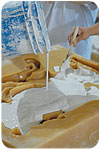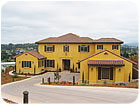

Pouring the plaster mold in a cradle that was made for pieces on a curved wall.
Located in southern Indiana's Orange County, the French Lick Springs Resort is an estimated $382-million preservation and renovation project. In April 2005, the Cook-Lauth Group purchased the resort and by May work began. The renovation encompasses not just the French Lick Springs Resort but also the historic West Baden Springs Hotel located one mile away, two golf courses (one designed by architect Pete Dye), casino and more. The resort is slated to open by the holiday season this year.
Like Cook-Lauth, two partners merged to work on this project. K&M Plastering is a nucleus of two subcontractors that came together as one. Founders Todd Kelly and Tracey Morron served as apprentices together in Indianapolis and have both been plastering since the late '80s. Working in roughly the same region of Indiana (primarily south of the capital, near Bloomington, with K&M's office in Bedford) both plasterers would help each other on jobs when scheduling was tight. Kelly would hire a couple workers for projects and his wife Tessa helped run the books with his previous company. Morron worked primarily with his brothers Randy and Brad. Since each of them did not have the manpower alone for the French Lick resort, they decided to form a partnership so they could work the job.

This home features seasoned-slaked lime plaster finishes for interior and exterior use. The project was completed by John Cravens Plastering, in Arroyo Grande, Calif.
Family business
"My dad Neil Kelly had ran the West Baden and I had worked with him for a number of years plastering," says Kelly, who is a fifth-generation plasterer. "I didn't know he knew how to run molds until we were there and then we started taking pieces down, making the boxes, pouring the rubber on them and the rest of the process."From this experience working with his dad, Kelly has continued the practice of decorative plaster work (Morron also had learned to run molds from Kelly senior).
For K&M, the scope of the job was all the ornate moldings sprinkled throughout the entire project, though mostly for lobbies, hallways, the spa area, casino and restaurants. Anything from crown, dentil and frieze molding to medallions and much more were recreated using molding plaster. Once all the molds had been made, specialty finishing contractor Conrad Schmitt Studios, of Milwaukee, followed with the paint and glazing for its final look. The general contractor for this project is Pritchett Brothers, also of Bedford.
One of K&M's more daunting tasks was to duplicate hundreds of rosettes that hung on the ceiling in the main lobby. When removing one of the original pieces, the electricians brought rosettes to the plasterers to make a casting of it so the lights could be reinstalled.
"We made 940 of those rosettes," says Morron. "We made a square box, set a light fixture in it, poured a rubber casting of it and progressed from there. Once we got the mold made, Stacy (Morron's daughter) poured those all summer last year. Morron's brother Randy would touch them up and slick them out so all the painters had to do was just glaze them."
In the spa area, the roof began to leak and several moldings inside crumbled away. K&M had the task of recreating brackets that had begun to weather and broken off. The company would do its best to take whatever material was salvageable and piece it back together.
"The material we poured the brackets out of was Hydro Cal by USG," says Kelly. "You can use just regular molding plaster to pour molds but the Hydro Cal makes a lot stronger piece. When there's a need to fasten screws in there when putting the pieces up, it's less likely to pop and it also makes a nice smooth looking piece."
Materials for this job were supplied by Acoustic Supply, of Indianapolis, whose sales person Steve Kelly was a plasterer with his cousin Todd Kelly before.
Morron also says the crew uses a lot of Tough Cal, another USG product, which has fiber in it to help support longer pieces that are fragile. "For blocky pieces, such as brackets, there isn't too much worry about them breaking," he says. "But if you got a slender piece that's brittle, we would use the Tough Cal and a lot of times we'd use EIFS mesh, as well. With mesh, we would cut little pieces of it and put it on the back of the molds. If a piece happened to break, at least it would be all together and the cracks could be filled when putting it up."
For the main lobby ceiling, huge medallions, 300 feet of crown molding and heavy pieces of frieze had to be carefully placed to center the massive Renaissance-style mural painted in the center. As Morron understands, old methods of applying these would be to "butter-up" the back with molding, which would bond well with bare plaster. However, if the wall had already been painted there is the risk of that coat becoming loose behind it and not holding.
The company drills into the heavier pieces, counter sinking screws in the existing plaster and into the wood behind it. Plus, on all molds, construction adhesive was used for extra reinforcement. As Kelly notes, there's a ton-and-a-half of plaster hanging from the ceiling. As an example, the frieze that was put up was made from three different pieces, fit together to make one unit that weighs 150 pounds.

Putting up a frieze that was reproduced from originals.
Profile runs
A challenge with creating molds of this size is fitting all the pieces in place to make it symmetrically correct. Occasionally, the company had to figure out how to place the pieces of the molds together without the aid of blueprints or plans."A lot of little cove pieces were missing so we made cutters, set them up on a board and ran those out on sticks," says Kelly. "One of the more interesting things we can do are the pieces that are ran out on the board-as long as it's smooth, it can run."
The company made dozens of cutters that were made for different profiles. This required Kelly and Morron to re-educate themselves on all of the various styles of molds and their proper names.
"There's been a lot of places where there's been a piece missing," says Kelly. "When we started the main lobby, one of the very first cutters we made around the top had a profile piece 5 inches wide that had a couple of steps down in it that specialty contractors tore out and built pipe chases beside the columns. Then they got rid of the pipe chases and we had to have the piece to put back in. We just made a cutter, ran it on the board, patched the hole, installed the piece back up there, mitered it and no one could tell it had been missing. There's been a lot of that done and we spent hours just building pieces like that."
The two explain how much they enjoy the process of running molds. They say to start out with a board that has a rail and design every cutter to that particular dimension so the rail can slide down through. With a cutter and a bucketful of mud, a piece of jute should be used for added strength. With a screw in each end and tied together, it should be pulled to the other end and mud poured over the top. One worker should mix the plaster and pour it while another person slides the cutter down. After this run, the material should set (which it will quickly). The cutter should then cleaned and buckets washed out and prepared to make the next batch (K&M say three batches). For each coat applied, it should progressively get thinner.
When this job folds, K&M will be leaving all of the mold profiles, knowing that at some point the next generation of plasterers working on the project may have to meet historical standards.
"When I first started plastering, I thought how great it would be to work on this hotel and the West Baden," says Kelly. "I'm proud I got the chance on both."
Photos taken by Kenneth Hayden Photography
Photos courtesy of USG
If you read this article, please circle number 336.

